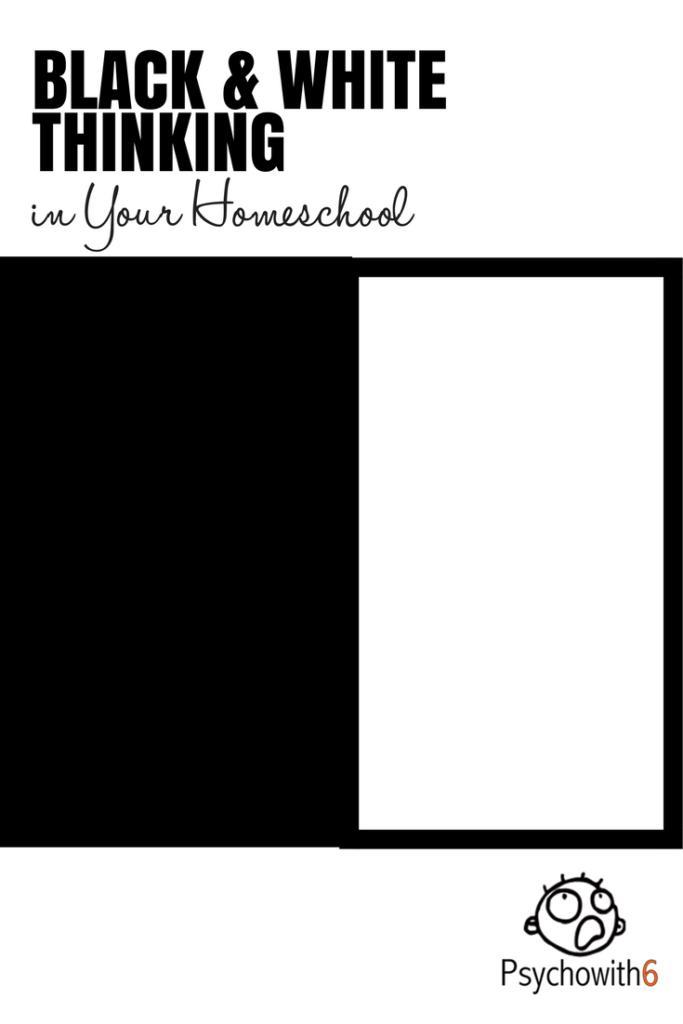If there was a simple way to turn your homeschool around, would you try it? It isn’t a new curriculum, a new teaching approach, or an organizing product. It’s a change in thinking.
“Are you having a good day?”
That question we throw around all the time invites black-and-white thinking. We are challenged to consider whether our day has been good or bad. Thinking in terms of black and white or in dichotomies or extremes is the definition of black-and-white thinking.
Why is black-and-white thinking a problem?
Black-and-white thinking ignores the large gray areas in our lives and homeschools. It is a common habit that our children easily pick up. I want to give you plenty of examples of black-and-white thinking that can play a role in our homeschools, but first I want to talk about the dangers of black-and-white thinking.
Black-and-white thinking depresses our mood. This is so because in thinking in extremes, we tend to gravitate toward the negative. Our thinking, when it is chronically negative, can lead to changes in brain chemistry. Depression, in turn, is a condition that must be addressed or it can have serious consequences for us and our families.
Black-and-white thinking is definitely something we want to change so we can model healthy thinking for our kids.
How black-and-white thinking affects our homeschools and how to change it
The first way black-and-white thinking can affect our homeschools is how we evaluate things. We evaluate our day. If we decide we are having a good day, we are likely to treat everyone around us well. We are likely to get a lot accomplished. But if we decide we are having a bad day, we may make everyone around us miserable and in a self fulfilling prophecy, we will behave in such a way that things go wrong. You get nothing done.
Black-and-white thinking leads us to evaluate not just our day but homeschooling in general. Rather than consider progress that we have made or the positive aspects mixed with the more challenging aspects, we are tempted to give homeschooling a good or bad rating. If we consistently give homeschooling a bad rating, we are very likely to consider quitting. Our children’s bad rating of homeschooling can contribute to that.
Black-and-white thinking also comes into play when evaluating curriculum and classes. We often ask our kids whether they like a curriculum or class instead of asking them what aspects of it they enjoy. In this type of questioning, we are leading our children into black-and-white thinking. We want to emphasize to our kids that every type of education, every class, and every curriculum has its pros and cons.
If you have already made the mistake of modeling black-and-white thinking for your kids, you can stop today. Ask your child what the best parts of homeschooling are. Ask what they enjoy most about a class or curriculum you are using. The change in attitude can be dramatic as a result of letting go of black-and-white thinking.
The next way in which black-and-white thinking plays a role in our homeschooling is in our assessments of ourselves. I have often heard homeschoolers say, “I’m not good at math. I can’t write.” These types of statements are rife with black-and-white thinking. It is not true that even my most math-phobic friend cannot do math. My friend may have struggled with some aspects of algebra. But that does not mean she is incapable of doing mathematics. In the same way when I have made the mistake of saying I’m not artistic in the past, the truth is that I can draw at a basic level. I will not be winning awards for my arts, nor will I be teaching an art class anytime soon. But to compare myself to professional artists or those who are gifted in arts and to pronounce myself incapable is not how we want to model for our kids.
Most abilities, we know from research, can be developed. We are each born with a range of potential. Homeschooling is our opportunity to help our kids reach the upper limits of that potential. For example, you may have a child who seems naturally musically gifted. Perhaps they can play by ear. You may have another child for whom music requires a great deal of concentration and practice. This does not mean that your child who works at music is not musical. This is especially something to watch for when it comes to sibling relationships. Children often believe that if one child is gifted in an area, that area is no longer available to them. Make sure you tell your kids that every one of them can be the smart one, the athletic one, the musical one, the spiritual one. That, in fact, is why you homeschool. To give your kids the opportunity to reach their potential.
In order to discourage black-and-white thinking in your homeschool, first and foremost refuse to make black-and-white statements about yourself. If you catch yourself saying, “I can’t do public speaking,” correct yourself and say, “Public speaking has been challenging for me in the past but if I work on it I can improve.”
When you hear your children making black-and-white statements about their day, homeschooling, or their own abilities, challenge them. Ask them to consider the gray areas. Use humor. Ask them if it is the case that every single thing has gone wrong in their day. Your child will most likely admit that no, not every single thing has gone wrong that day. Ask your child to consider the positive and negative aspects of all forms of education. Ask your child to consider what he or she has learned in a particular subject area. Make sure to challenge the notion that your child has not learned anything in a subject that is more challenging for them. At the same time that you challenge your children’s black-and-white thinking, invite them to challenge yours. Black-and-white thinking is very insidious. It will show up when you aren’t paying attention. We have to hold one another accountable. You have my permission to challenge my black and white thinking as well.
With time and attention, we can combat black-and-white thinking in our homeschools. As a result we can feel happier, our children can be more confident, and our homeschools can be more pleasant overall.







